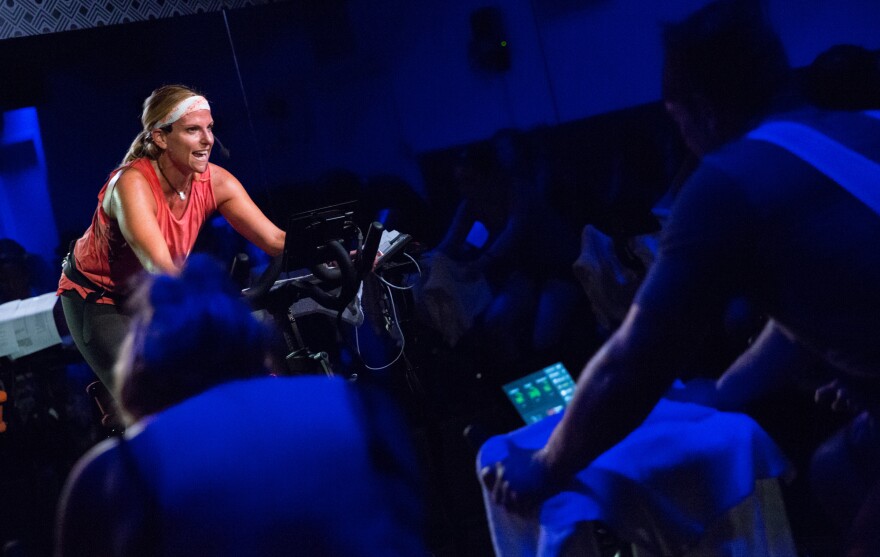Peek into a Peloton indoor cycling class in New York's posh Chelsea neighborhood and it'll look like most other indoor cycling classes. Sixty stationary bikes are clustered in a dark room, loud music blares to get the heart racing, and a mic-ed up instructor motivates riders.
Except this class has one major difference: Instructor Jen Sherman isn't just talking to riders in the classroom. She's also monitoring metrics for riders in places like New Jersey, California, Massachusetts and Kansas. "Jamie in Wichita, good to see you this morning," she says.
"There's an energy in the studio that's amazing, but when you factor in that you've got people that are riding with you from all over the country — all over the world at this point — it just takes it to another level," Sherman says.
Peloton CEO John Foley explains how they do it. "This is also a television production facility. There are five cameras, one of which rotates on a track around the room," he says.
Peloton bikes come outfitted with a custom waterproof tablet, enabling home riders to watch the action in Chelsea live as well as monitor their own metrics. It also ranks each rider's output on a virtual leader board.
For $40 a month, home riders have unlimited access to live and archived rides. That's in addition to the $2,000 it costs to buy the bike. It's a high bar for many. Still, more than 10,000 have signed up so far.
Greg Vadas from Bethesda, Md., keeps his Peloton bike tucked away in a small room in his basement next to his four real bikes. During a recent class, the instructor tells riders when to adjust their tension to simulate different elevations, but Vadas barely notices. He's only looking at one thing: the leaderboard.
"I have to admit, I don't pay that much attention to the instructor. I'm all about the board!" he says.
Peloton isn't the only company offering virtual instruction. Startup powhow.com allows fitness trainers to connect directly with clients via video chat and other tools, and that has radically changed home cardio workouts, says CEO Viva Chu.

"Back in the VHS or Beta days, you'd have Jane Fonda in your living room, but we're actually trying to take it one step further than that. It's like, you can not only work out with them on your own time, but you can also develop a personal relationship with them," Chu says.
While working out in front of a screen may seem weird, it's actually becoming much more the norm, says Cameron Jacobs, a research manager for the Sports and Fitness Industry Association.
"Many believe that technology, social media and physical activity somewhat run in conflict with one another, but that's not the case. Today we are finding being connected is getting people actually more benefits and maximizing their results from getting physically active," Jacobs says.
Whether it's a Fitbit watch or a metrics screen on a piece of exercise equipment, Jacobs says, the industry is adapting to make working out more interactive and immersive — entering into an exciting new era where classes are becoming fitness experiences and not just workouts.
"You need to have fun while you're getting physically active, because if it seems like a chore, it won't stick," Jacobs says.
Copyright 2021 NPR. To see more, visit https://www.npr.org.






